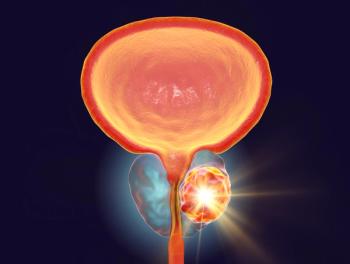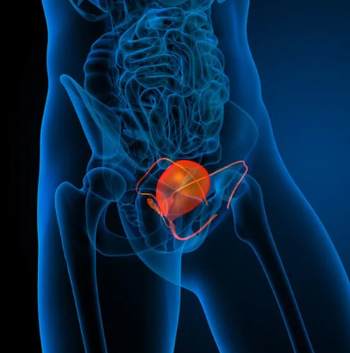
- ONCOLOGY Vol 15 No 7
- Volume 15
- Issue 7
Prostate Cancer and Spinal Cord Compression
Metastatic spinal disease is common in patients with prostate cancer. Spinal metastases may be asymptomatic (identified during staging) or cause pain and other neurologic signs and symptoms. In approximately 30% of prostate cancer patients,
Prostate cancer is the second leading cause of cancer death in menin the United States. Between 1% and 12% of men with adenocarcinoma of theprostate will develop spinal cord compression. Dr. Chen has presented anexcellent overview of a difficult clinical problem. At the risk ofoversimplification, the patient is generally an older male presenting with backpain, with or without neurologic involvement. If the patient has been diagnosedwith prostatic adenocarcinoma, the assumption is that he has metastatic diseaseof the spine, and this may indeed be the case. The advanced age of these men,however, predisposes to multiple other comorbidities. Other tumors may bepresent, immunosuppression may have predisposed to spinal column infection,hormonal ablation may have caused an osteoporotic compression fracture, orprevious spinal irradiation may lead to avascular necrosis of the vertebralbody.
Metastatic prostate cancer has a predilection for the thoracicspine. Although Batson’s plexus may be the conduit through which carcinomacells gain access to the vertebral column, I hold to the somewhat simplistictheory that tumor expression in the spinal column is based on the availabilityof vertebral bone marrow. Because the thoracic spine is the largest segment ofthe vertebral column, it offers the most vertebral sites for implantation ofcancer cells.
I agree with Dr. Chen’s algorithm for a diagnostic work-up andstrongly support his concept of total investigation of the spine in light of theknown incidence of multiple, discreet lesions in prostatic carcinoma, as well asthe possible problems.
Traditionally, surgery for spinal metastases has had threeroles:
biopsy
decompression to remove mechanical compression of the spinalcord or cauda equina
stabilization.
What If It Isn’t MetastaticSpinal Disease?
In this older population of men who present with pain, we haveto be certain that any abnormalities seen on imaging studies truly representmetastatic disease. Magnetic resonance imaging (MRI), x-ray, computed tomography(CT) scanning, and bone scanning all provide useful information, but often aCT-guided biopsy under local anesthesia will provide an accurate and rapiddiagnosis. Establishing a specific etiology for a spinal lesion is important inthat now there are very specific treatments for the different causes of spinepain. For example, kyphoplasty is gaining acceptance for use in osteoporoticfractures and certain malignancies. The procedure involves a percutaneousinjection of bone cement into the vertebral body, thus allowing simultaneousbone biopsy and restitution of vertebral body height and stability. This can beperformed over multiple levels in the spine, and is often effective in restoringalignment and providing pain relief. We must assume that we are not curing butonly ameliorating the symptoms of spinal metastatic disease and, to that end,kyphoplasty may have a significant advantage over open surgical procedures.
In spinal cord compression, radiation is often the first courseof treatment. Unfortunately, radiation will have no beneficial effect and may becontraindicated in patients with spinal instability, cord compression related tobone and not soft tissue, and preexisting spinal stenosis. In these cases,radiation may delay appropriate treatment and may predispose to soft-tissuebreakdown and sepsis if surgery is ultimately performed. Likewise, many patientshave already received maximal radiation to the area in question.
Limitations of Laminectomy
As Dr. Chen states, the earlier literature on surgery formetastatic disease usually suggested laminectomy as the procedure of choice.Posterior laminectomy is often contrary to Sutton’s Law: "Go where themoney is." Although laminectomy is useful when there is a mechanical blockin an otherwise stable spine, the vertebral body itself is often the site ofmetastatic disease and the tumor mass is anterior to the cord. Laminectomyremoves the only stable portion of the spinal column and often worsens theclinical situation.
If there is instability, laminectomy must be combined withposterior stabilization via pedicle screws or various hook/rod constructs.Surgical stabilization of the spine can obviate the need for bracing and allowsimmediate mobilization. If cord compression is anterior to the spinal cord, ananterior decompression and stabilization may be considered. The spine can bestabilized with an anterior allograft spacer or a titanium cage packed withautologous bone. Radiation must be deferred for at least 3 weeks after a frontor back fusion procedure so as to increase the opportunity for boneincorporation and decrease the opportunity for soft-tissue breakdown and sepsis.
Conclusions
Unfortunately, treatment options present ethical and therapeuticdilemmas. We are typically dealing with patients who are older and who haveother comorbidity. Usually, the extent of the systemic disease and comorbiditywill determine how aggressive the surgeon may or may not be. I agree with Dr.Chen’s statement that there are no correct answers as to how any individualpatient should be managed. Consultation among surgeon, oncologist, radiationtherapist, gerontologist, patient, and family is mandatory. It is important thateveryone fully appreciate the potential risks of surgery, specifically takinginto account age and comorbidity. It is also important that the goals of surgeryare well appreciatedie, we are hoping to ameliorate pain but, in alllikelihood, will not cure disease and may not cure severe neurologic defects.
I greatly appreciate Dr. Chen’s algorithms and his emphasis onthe fact that the treatment plan must be multidisciplinary and considered a workin progress. Postoperatively, there probably is a place for long-term treatmentwith bisphosphonates to help increase bone mass and prevent late osteoporosisand osteoporotic fractures.
Articles in this issue
over 24 years ago
Clinical Radiation Oncologyover 24 years ago
Gemcitabine Active in Patients With Metastatic Breast Cancerover 24 years ago
Irinotecan in Lung and Other Malignanciesover 24 years ago
Once-Yearly Leuprolide for Advanced Prostate Cancer Availableover 24 years ago
Environmental Links to Breast Cancerover 24 years ago
Bush Administration Considering Physician RatingsNewsletter
Stay up to date on recent advances in the multidisciplinary approach to cancer.

















































































